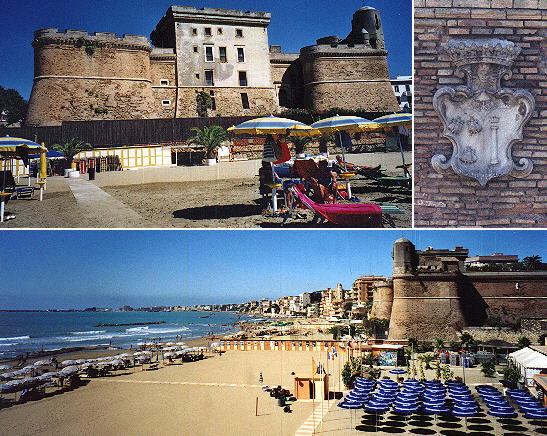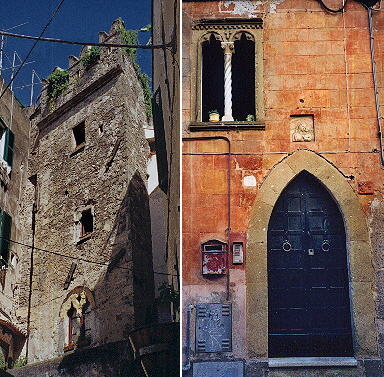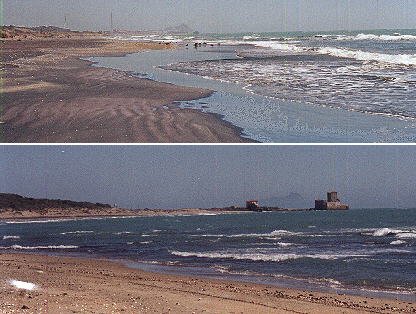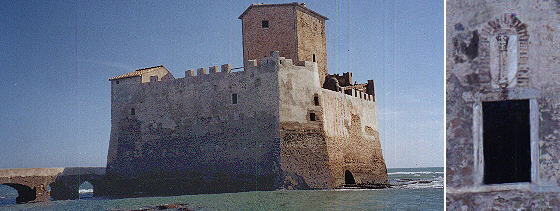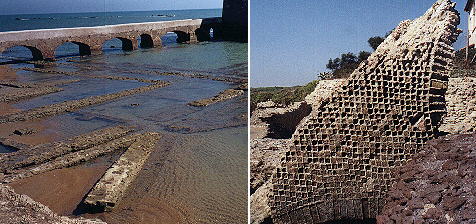

Ferdinand Gregorovius' Walks -
On the Latin shores - part two
Back to part one
In Anzio Gregorovius met a German painter and planned a walk with him to Torre Astura. They
first reached Nettuno.
Nettuno
Nettuno was for several centuries a fief of the Colonna family. Pope Alexander VI (his coat of arms is the background of this page)
erected here a fortress to protect the little town from the increased risk of raids by pirates coming from Tunis or Algiers: this was due to the fall
of Constantinople in 1453 and the expansion of the Turks in the Mediterranean. The fortress was built by Antonio da Sangallo, based on a design
by his brother Giuliano. Several coats of arms show the interest of the popes in this fortification.
Views of the fortress and joint coats of arms of the Barberini and the Colonna.
The town is very close to the fortress and protected by a set of walls and
towers which today separate the medieval borgo from modern Nettuno.
Medieval buildings in Nettuno
Torre Astura
The name of Torre Astura is associated with Conradin of Swabia, the last of the Hohenstaufen.
In 1267, at the age of 15 Conradin tried
to regain control of southern Italy, which his uncle Manfred had lost in 1266, beaten in
Benevento
by Charles of Anjou.
Conradin, with limited resources from Germany and a few very
young followers meandered for a while in northern Italy
until Pisa provided him the support to attempt the reconquest of Naples and Sicily.
He entered Rome, abandoned by the pope who preferred to stay in safer
Viterbo, and he received some help from the powerful Roman families. In August 1268, near
Tagliacozzo, his army seemed to defeat the Angevins of King Charles and
Conradin dispersed his forces to follow the fugitives. But Charles kept some fresh
forces as a reserve and threw them in the field at this point and won the battle.
Conradin managed to escape, reached Rome and
tried to go back to Pisa: in this attempt he came to Torre Astura, to a small castle of the Frangipane.
Giovanni Frangipane at first was inclined to help Conradin, but the emissaries of Charles
reached him and, after a few days of uncertainty, he handed over Conradin and his
young friends to Charles.
In October, after a mock trial, Conradin was beheaded in Naples. He was buried there in S. Maria del Carmine. A monument by Thorwaldsen was erected by Maximilian, Duke
of Bavaria.
His death at such a young age made Conradin an icon of the German nation. Gregorovius writes: "The fate of young Conradin was not forgotten. Three centuries later it played its part in the memories of the German nation, and through
the pictures of his execution distributed in Martin Luther's writings contributed
to strengthen the hand of the Protestant Reformer in his struggle with the papacy,
which did not fail.".
With these thoughts in mind Gregorovius and his friend moved along the beach towards Torre Astura.
Towards Torre Astura - behind it Monte Circello
Torre Astura is very small: the tower goes back to the XIIIth century, the outer walls are
slightly more recent, but
as a whole it has retained a medieval look with no concession to decoration and beauty apart from the column of the Colonna
over a small window. A little bridge is the only access to the castle.
Torre Astura and the coat of arms of the Colonna
In the immediate proximity of Torre Astura Roman remains testify the existence of large villas (Cicero had a villa in this location).
Remains of Roman villas
The walk towards Torre Astura is somewhat unique in today's Italy. The area between Nettuno and Torre Astura (including the latter) is
used by the Italian Army for artillery training. On weekdays walking along the beach is allowed only after the daily training is completed.
Should you visit this spot, you may find yourself, walking for miles in perfect solitude, (as it occurred to me to do) rehearsing a poem about ill fated Conradin (you can find it here below together with a German lieder).
CORRADINO DI SVEVIA
by Aleardo Aleardi
Mutiam dolore. Sull’estremo lembo
De la cerulea baia, ove i fastosi
Avi oziar nei placidi manieri,
Ermo, bruno, sinistro èvvi un castello.
Quando il corsaro fe’ quest’acque infami,
La paura lo eresse. Ivi da lunghi
Anni una fila d’augurosi corvi
É condannata a cingere volando
Ogni mattin le torri: ivi sui merli,
Fingendo il suono di cadente scure,
La più flebile fischia ala di vento:
Ivi pare di sangue incolorata
L’onda che sempre ne corrode il fondo:
Poi che una sera sul perfido ponte,
A consumar un’opera di sangue,
In sembianza di blando ospite stette
Il Tradimento.
Vuoi saperne il nome?
O fida come il sol, tu che non sai
Che sia tradire, deh! sègnati in prima
Col segno de la croce, Itala mia.
È il Castello d’Astura.
Un giovinetto
Pallido, e bello, con la chioma d’oro,
Con la pupilla del color del mare,
Con un viso gentil da sventurato,
Toccò la sponda dopo il lungo e mesto
Remigar de la fuga. Aveva la sveva
Stella d’argento sul cimiero azzuro,
Aveva l’aquila sveva in sul mantello;
E quantunque affidar non lo dovesse,
Corradino di Svevia era il suo nome.
Il nipote a’ superbi imperatori
Perseguito venìa limosinando
Una sola di sonno ora quieta.
E qui nel sonno ei fu tradito; e quivi
Per quanto affaticato occhio si posi,
Non trova mai da quella notte il sonno.
La più bella città de le marine
Vide fremendo fluttuar un velo
Funereo su la piazza: e una bipenne
Calar sul ceppo, ove posava un capo
Con la pupilla del color del mare,
Pallido, altero, e con la chioma d’oro.
E vide un guanto trasvolar dal palco
Sulla livida folla; e non fu scorto
Chi ‘l raccogliesse. Ma nel dì segnato
Che da le torri sicule tonaro
Come Arcangeli i Vespri ei fu veduto
Allor quel guanto, quasi mano viva,
Ghermir la fune che sonò l’appello
Dei beffardi Angioini innanzi a Dio.
Come dilegua una cadente stella,
Mutò zona lo svevo astro e disparve.
E gemendo l’avita aquila volse
Per morire al natìo Reno le piume;
Ma sul Reno era un castello,
E sul freddo verone era una madre,
Che lagrimava nell’attesa amara:
- Nobile augello che volando vai,
Se vieni da la dolce itala terra,
Dimmi, ài veduto il figlio mio?-
-Lo vidi;
Era biondo, era bianco, era beato,
Sotto l’arco d’un tempio era sepolto.-
|
CONRADIN VON SCHWABEN
(Nach der Chronik der Hohenstaufen. S. 492.)
Als Conradin zu Jahren kam,
Ein schnelle Sach sich bald vernahm,
Er wollt sich männlich halten,
Alle Erbländer nehmen ein,
Die von den Aeltern eigen sein,
Die wollt er frey verwalten.
Daß er sie frey und eigen hätt
Um Kriegsvolk thät er schreiben
Im Königreich, Fürstenthüm und Städt,
Da sollt niemand ausbleiben,
Sondern ihm treuen Beystand thun,
Bis er ein Heer zusammenbracht,
Hat er kein Rast und konnt nicht ruhn.
Als nun Papst Clemens solches vernahm,
Der Sache bald zuvor auch kam,
Thät auch ein Kriegsheer verschreiben.
Und schrieb dem Grafen Karl gleich,
Dem Bruder des Königs in Frankenreich,
Er sollte nicht ausbleiben,
Sondern Konrad wehren thun,
Und alle Päß verlegen.
Graf Karl thäts alsbald nun,
Er zog ihm straks entgegen,
Und machte durch Verrätherey,
Daß er Neapel genommen ein,
Eh Conradin noch kam herbey.
Karl der schicket aus gar viel
Verräther in geheimer Still,
Sie sollten Sperl einnehmen,
Denn Karl ließ gar viel darauf gehn,
In Papstes Namen ists geschehn,
Den Conradin zu dämmen;
Der Papst verhieß ihm grosses Gut,
Wenn er ihn möcht bestreiten,
Derhalben hielt er gute Hut,
Er ließ groß Gut erbiethen,
So die Verrätherey gemacht,
Die Steg und Weg daselbst er wußt,
Da rückt er bey in tiefer Nacht.
Conradin mit seinem Heer
Auf die Nacht da einkehrt.
Zu Morgens wollt er rücken
Ja ins Königreich Neapel ein!
Ließ ausrufen mit heller Stimm,
Sein Red wollt er nicht zucken,
Eh müß ihm drauf gehn Leib und Gut,
Er wolle es drauf setzen! -
Die Landsknecht sind nun wohlgemuth:
Die Reis' soll uns ergötzen!
Sie konnten sich nicht rüsten mehr,
Hineinzurücken in das Land,
Als schon der Feind vorhanden wär.
Nun höret zu, wie es ergieng,
Als sich der Schimpf mit Ernst anfieng,
Die Schanz ward hastlich übersehen.
Conradin hat gesiegt im Anfang,
Da über die Beut die Ordnung sank,
Da war der Schaden geschehen,
Sie waren übereilet schon
Von ihrem Gegentheile,
Deshalb empfingen bösen Lohn,
Ihre Haut war ihnen feile,
Der Vortheil übergeben ward,
Das Spiel, das war verloren schon,
Vermißt ward ihnen hier die Kron.
Es kostet manchen stolzen Mann,
Der seine Haut wollt rücken dran,
Zu retten seinen Herren,
Und ihm ein treuen Beystand thun
In Nöthen gänzlich nicht verloren,
Mit Tapferkeit zu wehren.
Es konnt damit doch nichts mehr seyn,
Sie waren überlänget,
Der Feind drang bald auf sie herein,
Daß sie wurden zerdränget,
Noch dennoch war ihr Herz so gut,
Eh einer seinen Herrn lassen wollt,
Vergossen sie ihr eigen Blut.
O Jammer über Jammersnoth,
Wie viel der Kriegsleut blieben todt,
Noch dennoch ward gefangen
Ihr Herr, für den sie Gut und Blut
Daran gesetzt aus freyem Muth,
Der must nun von hindannen
Mit einem Herzog zu Oesterreich,
Friedrich ward er genennet,
Sie wurden beyd hinweg zugleich
Geführet unzertrennet,
In die Hauptstadt, die ward genannt
Neapel von dem Königreich,
Gefangen sassens in ihrem Land.
Als Conradin gefangen war,
Wurd er gehalten grausam hart,
Mit samt dem Herzog Friedrich,
Verspottet, jämmerlich traktirt,
Zu einem Schauspiel umgeführt,
Und was man konnt erdichten. -
Den vorgen Tag der Held ging zu
Durch Berg und Thal mit glänzendem Heer;
Der Papst hat weder Rast noch Ruh,
Vor Neid konnt er nicht warten mehr,
Aus eitel Gift und grimmen Zorn
Gab er Befehl, daß man sollt schnell
Mit ihnen zum Gericht fortfahrn.
Man führt herfür die Fürsten beyd,
Wer hat gesehen solches Leid
Bey Denken aller Zeiten,
Da auf die Wahlstadt, die da war
Bereitet ihnen also baar,
Oeffentlich vor allen Leuten,
Man schlug ihnen beiden ihr Häupter ab,
Da war gar kein Erbarmen,
Es must daran der junge Knab
Mit seinen schneeweissen Armen,
Als er alt war sechzehen Jahr,
Durch den Papst Clemens den vierten
Ist das geschehen offenbar. |
Other walks with Ferdinand Gregorovius:
Roman Campagna (Aus der Campagna von Rom):
Palestrina
Genazzano
Paliano
Anagni
The Ernici Mountains (Aus den Bergen der Herniker):
Ferentino
Alatri
The Volsci Mountains (Aus den Bergen der Volsker):
Valmontone
Segni
Norma
Cori
On the Latin shores (Idyllen vom Lateinischen Ufer):
Anzio
Nettuno and Torre Astura
Circe's Cape (Das Kap der Circe):
Terracina
San Felice
The Orsini Castle in Bracciano
Subiaco, the oldest Benedictine monastery

Go to  or to
The Coats of Arms of the Popes or
to My Home Page on Baroque Rome or to
My Home Page on Rome in the footsteps of an XVIIIth century traveller or to
The Coats of Arms of the Popes or
to My Home Page on Baroque Rome or to
My Home Page on Rome in the footsteps of an XVIIIth century traveller

|


 or to
The Coats of Arms of the Popes or
to My Home Page on Baroque Rome or to
My Home Page on Rome in the footsteps of an XVIIIth century traveller
or to
The Coats of Arms of the Popes or
to My Home Page on Baroque Rome or to
My Home Page on Rome in the footsteps of an XVIIIth century traveller
